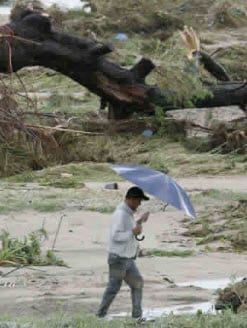 BOSTON, Sept. 22, 2011 -Catastrophe modeling firm AIR Worldwide estimates insured losses from Typhoon Roke at between JPY 12 billion (USD 150 million) and JPY 46 billion (USD 600 million). Typhoon Roke, the 15th named storm of the 2011 Northwest Pacific typhoon season, made landfall near Japan’s Hamamatsu City in Shizuoka Prefecture at 2:00 pm local time (05:00 UTC) on September 21. Maximum sustained winds at landfall were 180 km/h, making Roke a strong Category 2 storm. Note that this is the same range announced for Typhoon Talas on September 7th. Despite the similarity in estimated losses, however, Roke-primarily a wind event-was very unlike Talas-which was primarily a flood event-from a meteorological perspective.
BOSTON, Sept. 22, 2011 -Catastrophe modeling firm AIR Worldwide estimates insured losses from Typhoon Roke at between JPY 12 billion (USD 150 million) and JPY 46 billion (USD 600 million). Typhoon Roke, the 15th named storm of the 2011 Northwest Pacific typhoon season, made landfall near Japan’s Hamamatsu City in Shizuoka Prefecture at 2:00 pm local time (05:00 UTC) on September 21. Maximum sustained winds at landfall were 180 km/h, making Roke a strong Category 2 storm. Note that this is the same range announced for Typhoon Talas on September 7th. Despite the similarity in estimated losses, however, Roke-primarily a wind event-was very unlike Talas-which was primarily a flood event-from a meteorological perspective.
“After crossing more than 350 kilometers of the main Japanese island of Honshu-during which time it was undergoing extratropical transition and its winds were weakening to about 150 km/h-Roke moved out to sea in the North Pacific Ocean, where it has since further weakened,” said Dr. Peter Sousounis, principal scientist at AIR Worldwide.
Though Roke was primarily a wind event, the most readily available damage reports are from typhoon-induced flooding. As of the Japan Fire and Disaster Management Agency’s (FDMA) latest report today, roughly 550 homes have experienced inundation above the first floor level and more than 1,160 homes have experienced inundation below the first-floor. It should be noted that although Roke has exited Japan, the threat from typhoon-induced flooding and landslides persists; evacuation orders remain in place for 60,000 people living in the east coast prefectures of Aichi and Mie. In Odawara and Kanagawa prefectures, also on the country’s east coast, the threat of flooding and landslides has prompted the evacuation of 240,000 residents. In total, evacuation orders from Roke have impacted 1.21 million people.
Dr. Sousounis commented, “In terms of wind damage, Shizuoka prefecture was most heavily affected, although damage here and in other prefectures was mitigated by Roke’s short duration; the storm moved across central Japan in just 12 hours. Furthermore, Roke weakened quickly after landfall and its strongest winds remained over water as it moved across Japan and began extratropical transition, mitigating wind damage to onshore properties. All these factors contributed to Roke’s relatively low expected losses, despite the fact that the storm made landfall as a strong Category 2 typhoon, just 250 km southwest of Tokyo.”
According to AIR, Japan has strict and well-enforced construction codes; so far, minimal structural damage from wind has been reported. In Tokyo, there have been no reports of significant damage to buildings.
North of Tokyo, Roke’s passage over the Fukushima Dai-Ichi reactor buildings-which were significantly impacted by the Tohoku earthquake-has not caused further damage; the plant escaped the storm’s strongest winds. Roke did drop 204.5 millimeters of rain on Namie, a town nearby, however.
Dr. Sousounis stated, “Over the last several days, total precipitation amounts from Roke have exceeded 400mm at about a dozen monitoring stations; isolated mountainous regions have received 400-600 mm of rainfall. The rain from Roke has caused 28 landslides, according to the latest report from the FDMA, not to mention the flooding of streets and homes. Earlier this month, on September 2nd, another typhoon brought significant rainfall to Japan; though weaker at landfall, this storm-Tropical Storm Talas-was unusually large, with tropical storm force winds extending outwards up to 600 kilometers. It delivered up to 1,600 millimeters of rainfall in isolated parts of Nara Prefecture over a 24 hour period. By contrast, Roke’s smaller rainfall amount fell over the span of several days, mitigating its impact.”
As outlined above, although Roke had stronger winds than Talas, and thus might have been expected to cause significant wind damage, damage was mitigated by its short duration over Japan, its rapid inland weakening, and the position of its strongest winds, which were over open water. Thus, although some wind damage undoubtedly occurred, it was not as significant as might have been expected for a storm of Roke’s landfall intensity. Precipitation from Roke, meanwhile, was much less than that from Talas.
“As of the Japan Meteorological Agency’s (JMA) 6:40 UTC advisory today (1:40 am local time), Roke is an extratropical low, which means the storm has essentially left tropical latitudes and is now getting its energy from the atmosphere rather than from the ocean,” continued Dr. Sousounis. “Roke, located northeast of Hokkaido in the Sea of Okhotsk, is no longer a threat to Japanese soil.”
